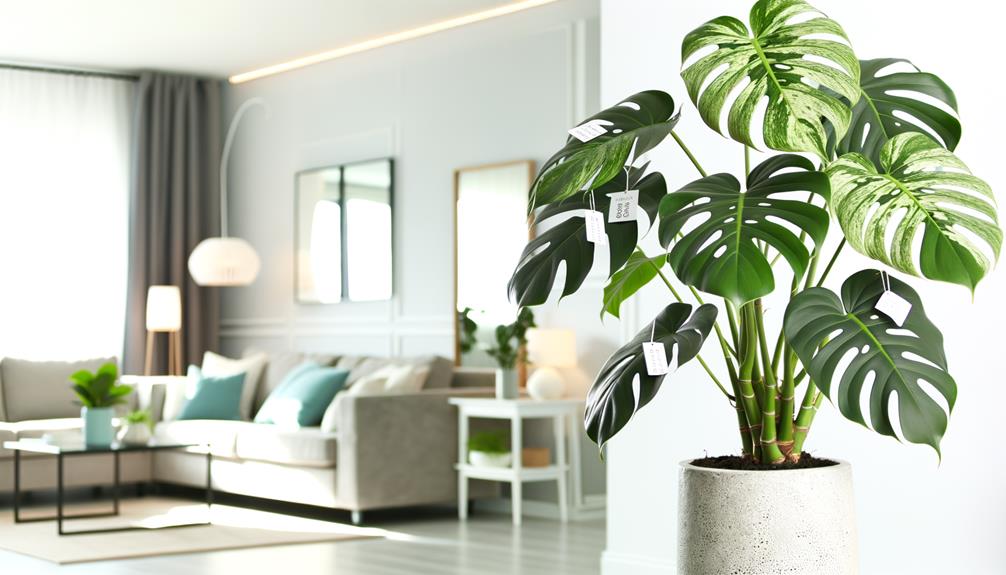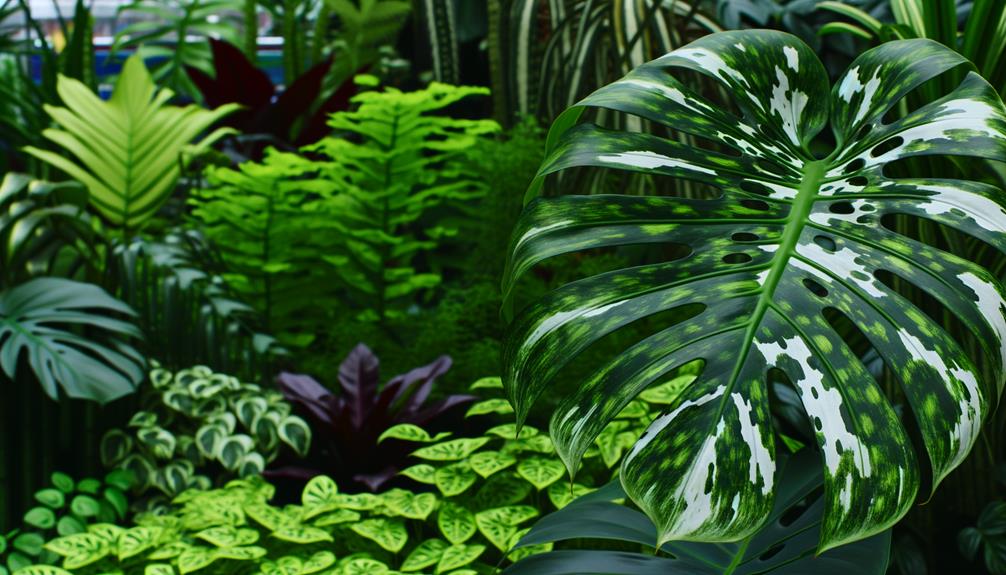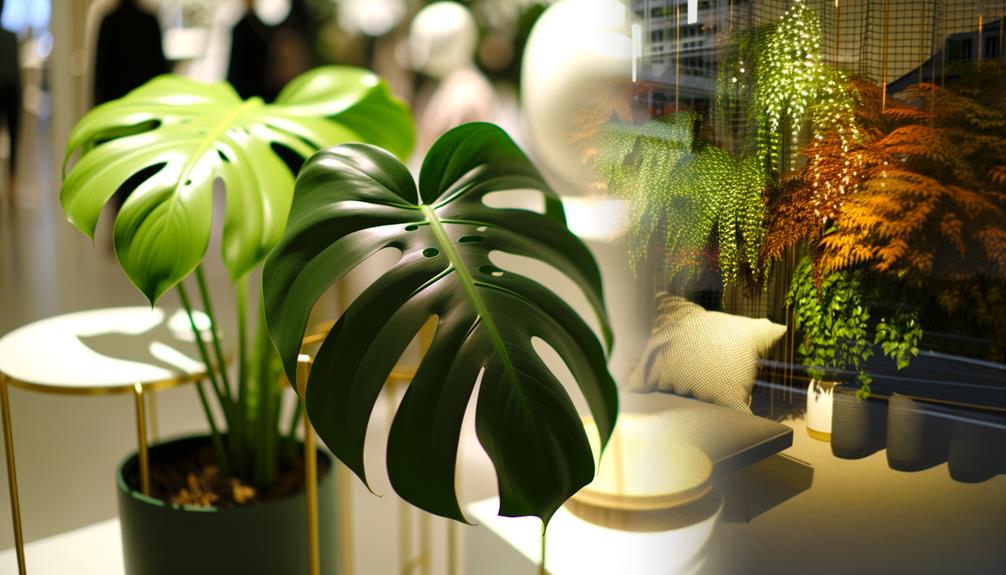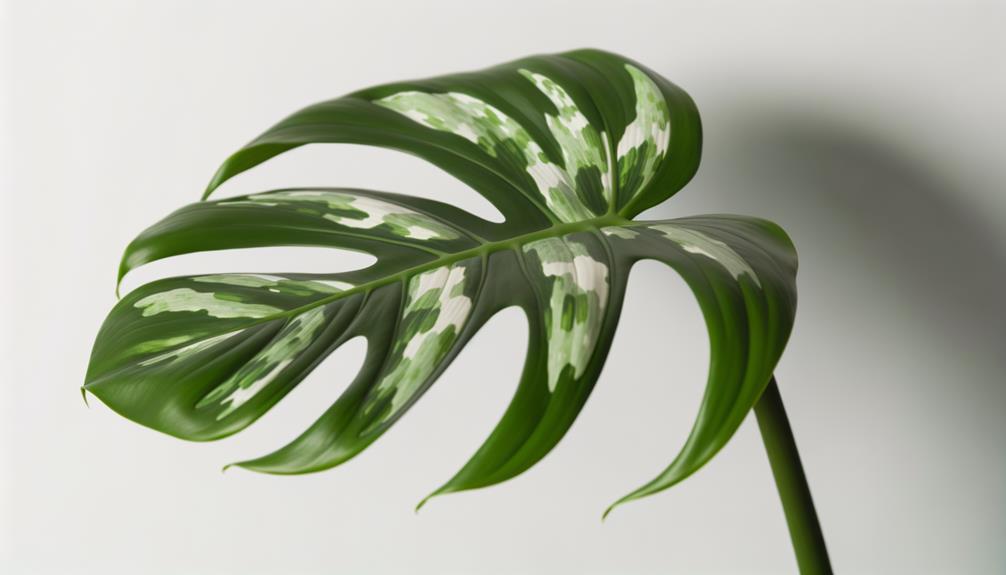How Much Is a Monstera Albo? Pricing Guide
According to recent data, the Monstera Albo’s price ranged from $9.79 to $154.00 in the last quarter. The average price hovered around $30 to $65, with some sellers offering largely sized plants for a higher price.
Plants with evenly distributed and stable variegation are pricier due to their desirability. Additionally, mature plants with more leaves are typically more expensive.
Regional availability, affected by growing conditions and import regulations, also plays a significant role. Seasonal variations in supply and demand can further influence pricing.
To understand how these factors interplay and determine the best purchasing strategy, more details await.
Price Trends
Over time, the Monstera Albo’s price has shown significant fluctuations. For instance, between October 2023 and February 2024, the average price increased by 225% and peaked in January 2024. After that, it decreased by 35% in February 2024.

Monstera Albo Pricing Guide 2024:Price Comparison
To provide a detailed comparison, here is a breakdown of the prices for a Monstera Albo across different sellers and platforms:
| Seller/Website | Low Price | Average Price | Median Price | Number of Listings | Last Seen |
|---|---|---|---|---|---|
| Etsy | $11.22 | $56.77 | $55.58 | Medium | February 2024 |
| Ebay | $7.99 | $15.94 | $16.31 | High | February 2024 |
| Listinge | $67 | $111.8 | $115.67 | Medium | February 2024 |
| Cultivar | $179 | $195 | $189 | Some | February 2024 |
| Amazon | $129.99 | $149.79 | $129.99 | Few | February 2024 |
| Steve’s Leaves | $28.99 | $94.59 | $64.49 | Few | February 2024 |
| Yume Gardens | $75 | $75 | $75 | Few | January 2024 |
| Bumble Plants | $425 | $425 | $425 | Few | February 2024 |
| Plant Zaddy Therapy | $15 | $41.25 | $32.5 | Few | February 2024 |
| Aroidplant | $75 | $93.75 | $75 | Few | February 2024 |
Additional Price Insights
- In 2023, the price of a mature and healthy Monstera Albo ranged from $55 to $148.
- One particular Monstera Albo plant on Etsy sold for $420.75.
- A user on Reddit mentioned purchasing an Albo Borsigiana plant for $220 on Ebay in 2020.
Pricing Summary:
- Lowest Price: $7.99 (Ebay)
- Highest Price: $425 (Bumble Plants)
- Average Price: $30 – $65 (across all sellers)
- Median Price: $55.58 (Etsy)
By understanding these price ranges and trends, potential buyers can make informed decisions about acquiring a Monstera Albo and its various cultivars.
Key Takeaways
- Monstera Albo prices vary widely, typically ranging from $100 to $500 depending on size and variegation quality.
- Rarity and stable variegation patterns significantly increase the price of Monstera Albo specimens.
- Larger plants with more mature leaves generally command higher prices.
- Online purchases may include additional shipping costs, affecting the overall price.
- Local demand and import restrictions can impact the availability and pricing of Monstera Albo.
Factors Influencing Price

When considering the price of a Monstera Albo, you must account for factors such as rarity, variegation quality, and plant size.
Rarity plays a significant role; the fewer the plants available, the higher the demand and price.
Variegation quality is essential too. Monstera Albo with evenly distributed white and green patches are more desirable and hence more expensive. The intensity and stability of variegation also impact the cost. Unstable variegation can lead to reversion, where the plant loses its unique coloring.
Size and Maturity
When evaluating the size and maturity of Monstera Albo, you’ll notice significant variations in growth rate due to environmental factors.
The number of leaves directly impacts the plant’s overall size and maturity, with more leaves generally indicating a more mature specimen.
Monitoring these aspects helps you understand the plant’s developmental stage and optimize care.
Growth Rate Variations
Growth rate variations in Monstera Albo are influenced by multiple factors including light exposure, soil quality, and humidity levels.
You’ll find that best growth occurs when the plant receives bright, indirect light. Excessive direct sunlight can cause leaf burn, slowing growth.
Soil quality is equally important; use well-draining, nutrient-rich soil to promote healthy root development. Overly compact or nutrient-poor soil inhibits growth.
Additionally, maintaining high humidity levels, around 60-70%, supports faster growth rates. Low humidity can cause leaf edges to brown and stunt growth. Regularly misting the plant or using a humidifier can mitigate this issue.
Leaf Count Impact
Understanding the impact of leaf count on the size and maturity of your Monstera Albo can further optimize its overall growth and aesthetic appeal. Each new leaf signifies a step towards maturity, influencing the plant’s structural development and vigor.
Increased leaf count usually indicates robust health and better photosynthetic efficiency, enhancing growth rates. Mature leaves tend to be larger and more fenestrated, contributing to the plant’s visual allure.
Regularly monitoring leaf count helps you gauge its growth stage and adjust care routines accordingly. Pruning older or damaged leaves can redirect energy to new growth, promoting a fuller, healthier plant.
Tracking leaf count isn’t just about aesthetics; it’s a critical factor in ensuring your Monstera Albo reaches its full potential.
Variegation Patterns

When examining Monstera Albo, you’ll notice that variegation patterns are essential.
You must consider types of variegation, which directly affect growth and maintenance needs, as well as influence the plant’s market value.
Analyzing these factors will provide a thorough understanding of the plant’s unique characteristics and care requirements.
Types of Variegation
In examining the types of variegation in Monstera Albo, you’ll encounter several distinct patterns, including marbling, sectoral, and splash variegation, each contributing uniquely to the plant’s aesthetic appeal.
Marbling features a mix of green and white, creating a mosaic effect. Sectoral variegation shows larger white patches, often in a more structured form. Splash variegation appears as scattered white spots across the leaf surface.
| Variegation Type | Description |
|---|---|
| Marbling | Mixed green and white mosaic effect |
| Sectoral | Larger, structured white patches |
| Splash | Scattered white spots |
| Blended | Combination of marbling and sectoral |
| Mint | Light green and white marbling |
Understanding these patterns helps you appreciate the diversity and complexity of Monstera Albo’s appearance.
Growth and Maintenance
Maintaining the variegation patterns in your Monstera Albo requires a careful balance of light, water, and nutrients.
First, make sure your plant receives bright, indirect sunlight; too much direct light can scorch the leaves, while too little can cause the variegation to fade.
Water consistently but avoid overwatering, as this can lead to root rot. Use well-draining soil to facilitate proper moisture levels.
Fertilize monthly with a balanced, water-soluble fertilizer to support healthy growth.
Monitor humidity, keeping it between 60-80%, as dry air can stress the plant and affect variegation.
Prune any fully green leaves to encourage more variegated growth.
Market Value Impact
Proper care techniques not only ensure vibrant variegation but also greatly influence the market value of Monstera Albo, as buyers often prioritize plants with distinct and stable variegation patterns. You’ll find that consistent light exposure, ideal humidity, and balanced nutrients play key roles in achieving these patterns.
Variegation stability, characterized by a balanced mix of green and white sectors, is highly sought after. Plants exhibiting high contrast and well-distributed variegation command higher prices. Additionally, the absence of reversion—where the plant loses its variegation—significantly impacts value.
Monitoring and adjusting care parameters is essential to maintaining these desirable traits. Understanding these factors helps you position your Monstera Albo effectively in the market, maximizing its potential value.
Market Demand
Demand for Monstera Albo has surged due to its unique variegated foliage and the growing popularity of rare houseplants among collectors. You’ll notice that the distinct white and green marbling on the leaves makes Monstera Albo highly desirable.
This demand is further driven by social media platforms where plant enthusiasts showcase their collections, thereby amplifying interest.
Analyzing market trends, you’ll find that limited supply exacerbates the demand. Monstera Albo propagates slower than non-variegated varieties, making it less readily available. As a result, sellers often face backorders, and waiting lists are common.
This scarcity, in turn, inflates prices, making the plant an investment for serious collectors. Understanding these dynamics helps you grasp why market demand remains consistently high.
Geographic Location

When considering Monstera Albo, you’ll notice significant regional price differences due to local supply and demand factors.
Availability varies widely by area, influenced by climate conditions and import regulations.
Analyzing these factors will help you understand the market dynamics and optimize your purchasing strategy.
Regional Price Differences
Regional price variances for Monstera Albo are influenced by factors such as local climate conditions, import regulations, and market demand dynamics. You’ll find that the cost can fluctuate significantly depending on where you are.
For a deeper understanding, consider these elements:
- Local Climate Conditions: Regions with ideal growing conditions may see lower prices due to higher local supply.
- Import Regulations: Strict import laws can increase costs due to added logistics and compliance expenses.
- Market Demand Dynamics: High demand in urban areas often drives prices upwards, reflecting the plant’s popularity.
- Economic Factors: Fluctuations in local currency strength and economic conditions can also impact pricing.
Understanding these factors will help you navigate the complexities of purchasing a Monstera Albo.
Availability by Area
Understanding Monstera Albo’s availability requires analyzing how geographic location influences both supply chains and cultivation feasibility.
In regions with tropical climates, such as Southeast Asia or Central America, you’ll find that local nurseries can cultivate Monstera Albo more easily due to favorable growing conditions. Conversely, in temperate zones like Europe or North America, the plant’s availability decreases, as growers rely on controlled environments, which heightens costs and reduces supply.
Additionally, import restrictions and phytosanitary regulations notably impact availability. Countries with stringent import laws may face limited supply, driving up prices.
Local demand dynamics also play a role; urban areas with a high concentration of plant enthusiasts often see quicker stock turnover and higher prices, compared to rural areas where demand is lower.
Online Vs. Local Shops
Choosing between online and local shops for purchasing Monstera Albo involves analyzing factors such as plant quality, availability, cost, and convenience.
Online shops often provide a wider selection, but you can’t inspect the plant before purchase. Shipping can also stress the plant, affecting its health.
Local shops allow you to examine the plant’s condition firsthand, and you won’t face shipping delays. Costs vary, with online shops sometimes offering lower prices but adding shipping fees.
Consider these aspects:
- Quality: Inspect plants locally; rely on reviews online.
- Availability: Online shops may have rare varieties.
- Cost: Factor in shipping for online purchases.
- Convenience: Local purchases avoid shipping delays.
Ultimately, weigh these factors to decide the best purchasing method for your needs.
Seasonal Variations

Seasonal fluctuations greatly impact the growth and care requirements of Monstera Albo, necessitating adjustments in watering, lighting, and humidity levels throughout the year.
During summer, you’ll need to increase watering frequency as higher temperatures accelerate soil drying. Conversely, in winter, reduce watering to avoid root rot due to slower evaporation rates.
Light intensity also varies; provide more indirect light during shorter winter days to compensate for reduced natural sunlight.
Humidity levels require careful monitoring: summer’s higher humidity can enhance growth, while winter’s dry indoor air might require a humidifier to maintain ideal levels.
Care and Maintenance
Effective care and maintenance of Monstera Albo hinge on meticulous attention to watering practices, light exposure, and humidity control.
You’ll need to water your Monstera Albo when the surface layer of soil feels dry, ensuring the soil remains well-drained.
Best light conditions include bright, indirect sunlight to promote variegation without scorching the leaves.
Maintaining humidity levels between 60-80% is ideal, as Monstera Albo thrives in humid environments.
- Watering: Allow the surface layer of soil to dry before watering.
- Light: Provide bright, indirect sunlight.
- Humidity: Maintain 60-80% humidity.
- Soil: Use well-draining, aerated soil.
Rare Specimens

In the world of Monstera Albo, rare specimens are highly coveted for their unique variegation patterns and genetic mutations. You’ll find that these plants often exhibit striking white and green marbling, sometimes with sectors almost entirely devoid of chlorophyll.
This rarity makes them both a collector’s dream and a challenge to propagate. Because of their unstable variegation, these plants require meticulous care to maintain their aesthetic appeal. The genetic mutations responsible for these patterns aren’t easily replicated, making each plant unique.
Prices for these rarities can fluctuate significantly based on the extent and symmetry of the variegation, as well as the plant’s overall health. Understanding these factors can help you appreciate why rare Monstera Albo specimens command such high prices.
Budget-Friendly Alternatives
For those who admire the beauty of Monstera Albo but are constrained by budget, there are several affordable alternatives that mimic its variegated appearance. These options provide a similar aesthetic without the high cost associated with rare specimens.
- Monstera Adansonii: Known as the Swiss Cheese Plant, it offers a striking appearance with its unique leaf holes.
- Pothos N’Joy: This plant features variegated leaves with white and green patterns that closely resemble Monstera Albo’s unique look.
- Philodendron Birkin: With its striking white pinstripes on dark green leaves, it offers a sophisticated, variegated appearance.
- Spider Plant (Chlorophytum comosum ‘Variegatum’): Its variegated leaves provide a lush, aesthetic appeal at a fraction of the cost.
These alternatives guarantee you enjoy a similar variegated beauty without straining your budget.
Conclusion
Ironically, while you’re meticulously calculating Monstera Albo prices based on size, variegation, and market demand, the plant’s true cost lies in the ongoing care and maintenance it demands. Geographic and seasonal factors will further complicate your budget, making rare specimens a literal investment.
Yet, despite your detailed analysis, you might find budget-friendly alternatives offering similar aesthetic satisfaction. So, perhaps the real question isn’t ‘how much is a Monstera Albo?’ but rather, ‘is it worth the constant effort?’





